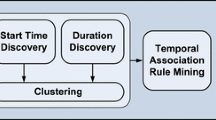Abstract
People may do the same activity in many different ways hence, modeling and recognizing that activity based on data gathered through simple sensors like motion sensor is a complex task. In this paper, we propose an approach for activity mining and activity tracking which identifies frequent normal and interleaved activities that individuals perform. With this capability, we can track the occurrence of regular activities to monitor users and detect changes in an individual’s behavioral pattern and lifestyle. We have tested the proposed method using the datasets of Washington State University CASAS and the Massachusetts Institute of Technology (MIT) smart home projects. The obtained results show considerable improvements compared with existing methods.











Similar content being viewed by others
References
Raeiszadeh M, Tahayori H (2018) “A novel method for detecting and predicting resident’s behavior in smart home,” 6th Iran. Jt. Congr. Fuzzy Intell. Syst., p. 71–74
Mahya P, Tahayori H, Sadeghian A (2017) “An online demand response EMS with anomaly usage detection,” 5th IEEE Int. Conf. Smart Energy Grid Eng., pp. 271–275
Liouane Z, Lemlouma T, Roose P, Weis F, Messaoud H (2017) An improved extreme learning machine model for the prediction of human scenarios in smart homes. Springer J Appl Intell 48(8):2017–2030
Mshali H, Lemlouma T, Moloney M, Magoni D (2018) A survey on health monitoring systems for health smart homes. Int J Ind Ergon 66:26–56
Munoz A, Augusto JC, Villa A, Botia JA (2011) Design and evaluation of an ambient assisted living system based on an argumentative multi-agent system. Pers Ubiquitous Comput 15(4):377–387
Rashidi P, Cook DJ (2009) Keeping the resident in the loop: adapting the smart home to the user. IEEE Trans Syst Man, Cybern Part ASystems Humans 39(5):949–959
Tapia EM, Intille SS, Larson K (2004) Activity recognisation in home using simple state changing sensors. Pervasive Comput 3001:158–175
van Kasteren T, Krose B (2007) Bayesian activity recognition in residence for elders. In: 3rd IET Int. Conf. Intell. Environ. (IE 07), vol 2007, pp 209–212
Brdiczka O, Crowley JL (2016) Learning situation models in a smart home learning situation models in a smart home. IEEE Trans. Syst. Man, Cybern. Part ASystems Humans 39(1):56–63
Lombriser C, Bharatula NB, Roggen D, Tröster G (2007) “On-body activity recognition in a dynamic sensor network,” Proc. ICST 2nd Int. Conf. Body area networks, pp. 1–6
Allahviranloo M, Recker W (2013) Daily activity pattern recognition by using support vector machines with multiple classes. Transp Res Part B 58:16–43
Mehr HD, Polat H, Cetin A (2016) Resident activity recognition in smart homes by using artificial neural networks, 4th Int. Istanbul Smart Grid Congr. Fair
Favela J, Tentori M, Castro LA, Gonzalez VM, Moran EB, Martinez-Garcia AI (2007) Activity recognition for context-aware hospital applications: issues and opportunities for the deployment of pervasive networks. Mob Networks Appl 12(2–3):155–171
Maurer U, Smailagic A, Siewiorek DP, Deisher M (2006) “Activity recognition and monitoring using multiple sensors on different body positions,” Int Work Wearable Implant Body Sens Networks, pp. 4–7
Singla G, Cook DJ (2009) Interleaved activity recognition for smart home residents, 5th IEEE Int. Conf. Intelliget environ., pp. 145–152
Alam MR, Reaz MBI, Mohd Ali MA (2012) SPEED: an inhabitant activity prediction algorithm for smart homes. IEEE Trans. Syst. Man, Cybern. Part ASystems Humans 42(4):985–990
Liao L, Fox D, Kautz H (2005) Location-based activity recognition using relational Markov networks, 19th Int. Jt. Conf. Artif. Intell., pp. 773–778
Jakkula VR, Cook DJ (2007) “Using temporal relations in smart environment data for activity prediction,” 24th Int. Conf. Mach. Learn
Rashidi P, Cook DJ, Holder LB, Schmitter-Edgecombe M (2011) Discovering activities to recognize and track in a smart environment. IEEE Trans Knowl Data Eng 23(4):527–539
Bourobou STM, Yoo Y (2015) User activity recognition in smart homes using pattern clustering applied to temporal ANN algorithm. Sensors (Switzerland) 15(5):11953–11971
Riabov A, Liu ZLZ, Wolf JL, Yu PS, Zhang LZL (2003) “Clustering algorithms for content-based publication-subscription systems,” 23rd Int. Conf. Distrib. Comput. Syst. 2003. Proceedings., pp. 133–142
Rashidi P, Cook DJ (2009) Transferring learned activities in smart environments. Ambient Intell Smart Environ Intell Environ 2:185–192
Olivier MS, Tillwick HM, Venter HS, Africa S (2005) Using self-organizing maps for anomalous behavior detection in a computer forensic investigation, Inf. Comput. Secur. Archit. Res. Gr
Zhao Z, Yan D, Ng W (2014) Mining probabilistically frequent sequential patterns in large uncertain databases. IEEE Trans Knowl Data Eng 26(5):1171–1184
Pei J, Han J, Chen Q, Hsu MC, Mortazavi-Asl B, Pinto H (2001) “PrefixSpan: mining sequential patterns efficiently by prefix-projected pattern growth,” Int. Conf. Data Eng., pp. 215–224
Kotal KKSA (2013) A new algorithm to find longest common sub-sequences. Int J Sci c Eng Res 4(5):664–669
Author information
Authors and Affiliations
Corresponding author
Additional information
Publisher’s note
Springer Nature remains neutral with regard to jurisdictional claims in published maps and institutional affiliations.
Rights and permissions
About this article
Cite this article
Raeiszadeh, M., Tahayori, H. & Visconti, A. Discovering varying patterns of Normal and interleaved ADLs in smart homes. Appl Intell 49, 4175–4188 (2019). https://doi.org/10.1007/s10489-019-01493-6
Published:
Issue Date:
DOI: https://doi.org/10.1007/s10489-019-01493-6




